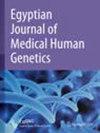胆囊癌恶性病变中 miR 499 表达和幽门螺杆菌感染的预后意义:一项临床病理学研究
IF 1.2
Q4 GENETICS & HEREDITY
引用次数: 0
摘要
胆囊癌(GBC)是世界上一种不常见的恶性肿瘤。有许多风险因素会增加罹患 GBC 的可能性。包括胆石症在内的胆囊炎症(GID)疾病会增加罹患 GBC 的风险,而在印度,幽门螺杆菌(H. pylori)感染在胃肠道中极为常见,这使情况变得更加复杂。由于 miR 499 和幽门螺杆菌感染都与肿瘤进展和转移有关,因此幽门螺杆菌有可能通过失调 miR 499 参与炎症。本研究旨在探讨 miR 499 表达与幽门螺杆菌感染的关系及其与 GBC 临床病理参数的相关性。本研究使用的 103 份组织样本分为 GID(55 份)和 GBC(48 份)。采用 Livak 法进行相对基因表达分析,检测 miR-499 的表达。幽门螺杆菌感染与否通过 RT-PCR (Liferiver 幽门螺杆菌 RT-PCR 试剂盒)检测。幽门螺杆菌感染与 GBC/GID 病例无明显相关性。与 GID 患者相比,在 GBC 中观察到 miR 499 表达降低(1.6 倍)(P < 0.0001)。研究发现,miR 499的低表达与肿瘤分化(P = 0.017)、晚期分期(P = 0.004)和肝转移(P = 0.036)明显相关。多变量回归分析表明,miR 499的低表达与总生存率有显著相关性。本文章由计算机程序翻译,如有差异,请以英文原文为准。
Prognostic significance of miR 499 expression and Helicobacter pylori infection in malignant lesions of gallbladder cancer: a clinicopathological study
Gallbladder cancer (GBC) is an infrequent type of malignant neoplasm worldwide. There are a number of risk factors that increase a person's likelihood of developing GBC. Gallbladder inflammatory (GID) diseases including cholelithiasis increase the risk of GBC, and this is further complicated by the fact that Helicobacter pylori (H. pylori) infection is extremely common in gastrointestinal tract in India. Since both miR 499 and H. pylori infection are found to be linked with tumor progression and metastasis, therefore there is a possibility that H. pylori might be involved in inflammation via dysregulation of miR 499. The study was designed to investigate the association of miR 499 expressions with H. pylori infection and their correlation with clinicopathological parameters of GBC. The hundred three tissue samples used in this study are categorized into GID (n = 55) and GBC (n = 48). The expression of miR-499 was examined by using the Livak method for relative gene expression analysis. The presence/absence of H. pylori infection was examined by RT-PCR (Liferiver Helicobacter pylori RT-PCR Kit). Helicobacter pylori infection and GBC/GID cases were not significantly correlated. Decreased expression of miR 499 was observed in GBC (1.6 fold) as compared to GID patients (P < 0.0001). Low miR 499 expression was found to significantly correlate with tumor differentiation (P = 0.017), advanced staging (P = 0.004) and liver metastasis (P = 0.036). Multivariate regression analysis showed significant association of overall survival with low miR 499 expressions. miR 499 may be considered as a useful prognostic biomarker in GBC progression.
求助全文
通过发布文献求助,成功后即可免费获取论文全文。
去求助
来源期刊

Egyptian Journal of Medical Human Genetics
Medicine-Genetics (clinical)
CiteScore
2.20
自引率
7.70%
发文量
150
审稿时长
18 weeks
 求助内容:
求助内容: 应助结果提醒方式:
应助结果提醒方式:


